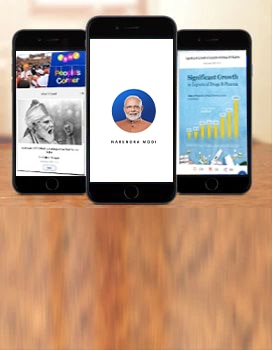In October 2011, the Central Government asked all states and union territories to implement the computerized Public Distribution System (PDS) model implemented by Gujarat and Chhattisgarh (also a BJP ruled state). This came after the Supreme Court lauded the models of these two. The Supreme Court direction was based on the recommendations of a committee headed by Justice DP Wadhwa, a former judge of the Supreme Court.
It was noted that Gujarat’s PDS could be a model in electronic authentication of delivery and payments at the fair price shop. Even the United Nations World Food Programme has noted the success of Gujarat’s Targeted PDS reforms model.
These reforms would not be possible without the inspiring guidance and leadership of Chief Minister Shri Narendra Modi, who invigorated the system with some of the Shaktis from his timeless Panchshakti model and made a strong determination that the benefits of the system reach the intended beneficiaries without any bottlenecks.

The PDS
The Public Distribution System is one of the largest food security programmes in our country that has been operational for many decades, distributing food and non-food items to India’s poor. However, for a very long time the system has been characterized by some flaws, diversions and leakages. There is also the problem of bogus or duplicate ration cards.
Tackling Problems, the Gujarat Way!
In its quest to solve existing problems, the Gujarat Government did not wait for help from outside but instead decided to tackle the crisis from within. With the support of a stable leadership and a visionary Chief Minister in Shri Modi, the State Government provided all the essential resources for a model of TPDS that has been hailed universally.
This model relies on extensive incorporation and usage of technology as well as empowering the citizen to establish his or her identity and avail of the food grains minimizing leakages and diversions.
It should be noted that the Gujarat’s TPDS reform model has been fully funded by the state Government and has been one of the most cost effective projects.
Some of the Reforms Initiated
One of the major successes of Gujarat’s TPDS reforms has been the elimination of bogus cards. Along with that the state has achieved the autonomination of TPDS (which is still in process). This has improved the response time of TPDS administration and curbed corruption, if any.
However, elimination of bogus cards in no ways implies successful delivery. This is where the Bar Coded Ration Card and biometric Bar Coded Coupon System assume importance. Pilot projects are underway in various parts of the state since 2011. A cardholder is issued a coupon sheet that he or her can take to the FPS and avail of the items. The FPS dealers collect the coupons and hands over the desired items. This reduces the scope of stealing.
Some of the proposed reforms include compensating FPS dealers for the coupon based transactions, door step delivery of food grain to FPS dealers and popularizing model FPS scheme and permitting sale of non-PDS items at FPS.

Reforms Possible Due to Progressive Initiatives of Gujarat Government
These changes in the TPDS would not be possible without the strong support thanks to the initiatives of the Gujarat Government. Leading the pack is the Jyotigram Yojana, which has given a lifeline by providing 24/7 electricity. This becomes the fulcrum of the e-GRAM center, which is at the centre of these reforms in the TPDS.
A part of Shri Modi’s Panchamrut Philosophy, Jan Shakti is at the very crux of Gujarat’s TPDS reform model. A lot of reforms and changes are possible with an empowered citizenry. Similarly, innovative use of technology has been of great help in giving teeth to the reforms.
This important transformation by the Gujarat Government yet again shows how inspiring leadership and combined with a determination to change things of the ground can deliver extremely fruitful and satisfying results that would benefit the common man!
References Cited:
Heavy content usage from- https://www.narendramodi.in/gujarat-revolutionizes-the-targeted-public-distribution-system-tpds/
Additional Sources-














